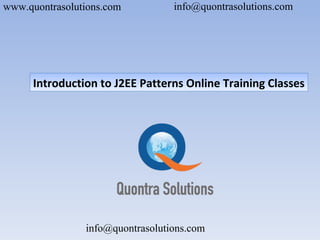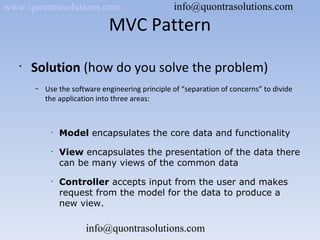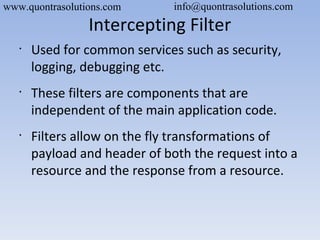Introduction to j2 ee patterns online training class
- 1. www.quontrasolutions.com info@quontrasolutions.com info@quontrasolutions.com Introduction to J2EE Patterns Online Training Classes
- 2. Design Patterns • A pattern is a proven solution to a problem in a context. • Christopher Alexander says each pattern is a three-part rule which expresses a relation between a certain context, a problem, and a solution. • Design patterns represent a solutions to problems that arise when developing software within a particular context. www.quontrasolutions.com info@quontrasolutions.com
- 3. Categorizing Pattern Patterns, then, represent expert solutions to recurring problems in a context and thus have been captured at many levels of abstraction and in numerous domains. Numerous categories are: • Design • Architectural www.quontrasolutions.com info@quontrasolutions.com
- 4. MVC Design Pattern • Name (essence of the pattern) – Model View Controller MVC • Context (where does this problem occur) – MVC is an architectural pattern that is used when developing interactive application such as a shopping cart on the Internet. • Problem (definition of the reoccurring difficulty) – User interfaces change often, especially on the internet where look- and-feel is a competitive issue. Also, the same information is presented in different ways. The core business logic and data is www.quontrasolutions.com info@quontrasolutions.com info@quontrasolutions.com
- 5. MVC Pattern • Solution (how do you solve the problem) – Use the software engineering principle of “separation of concerns” to divide the application into three areas: • Model encapsulates the core data and functionality • View encapsulates the presentation of the data there can be many views of the common data • Controller accepts input from the user and makes request from the model for the data to produce a new view. www.quontrasolutions.com info@quontrasolutions.com info@quontrasolutions.com
- 6. MVC Architecture • The Model represents the structure of the data in the application, as well as application- specific operations on those data. • A View (of which there may be many) presents data in some form to a user, in the context of some application function. www.quontrasolutions.com info@quontrasolutions.com
- 7. Intercepting Filter • Context: The presentation-tier request handling mechanism receives many different types of requests, which require varied types of processing before forwarding to handler. • Problem: Preprocessing and post-processing of a client Web request and response are required. • Solution: Create pluggable filters to process common services in a standard manner without requiring changes to core request www.quontrasolutions.com info@quontrasolutions.com info@quontrasolutions.co.uk
- 8. Intercepting Filter • Used for common services such as security, logging, debugging etc. • These filters are components that are independent of the main application code. • Filters allow on the fly transformations of payload and header of both the request into a resource and the response from a resource. www.quontrasolutions.com info@quontrasolutions.com
- 9. Writing a Filter • Implement the javax.servlet.Filter interface • Container will call the doFilter() method. • The doFilter method will modify the request or response and then call the next filter in the filter chain. • The FilterManager manages filter processing. It creates the FilterChain with the appropriate filters, in the correct order, and initiates processing. www.quontrasolutions.com info@quontrasolutions.com
- 10. Filter Configuration • Configuring filter in the deployment descriptor ( web.xml ) • <filter> • <filter-name>Image Filter</filter-name> • <filter-class>com.acme.ImageFilter</filter- class> • </filter> • <filter-mapping> • <filter-name>Image Filter</filter-name> • <url-pattern>/*</url-pattern> www.quontrasolutions.com info@quontrasolutions.com
- 11. Interceptor Filter Pattern www.quontrasolutions.com info@quontrasolutions.com info@quontrasolutions.com
- 12. Filter: Sequence Diagram www.quontrasolutions.com info@quontrasolutions.com info@quontrasolutions.co.uk
- 13. Front Controller • Context: The presentation-tier request handling mechanism must control and coordinate processing of each user across multiple requests, in either a centralized or decentralized manner. • Problem: The system requires a centralized access point for presentation-tier request handling to support the integration of system services, content retrieval, view management, and navigation. www.quontrasolutions.com info@quontrasolutions.com
- 14. Front Controller • Solution: Use a controller as the initial point of contact for handling a request. • The controller manages the handling of the request, including invoking security services such as authentication and authorization, delegating business processing, managing the choice of an appropriate view, handling errors, and managing the selection of content creation strategies. www.quontrasolutions.com info@quontrasolutions.com info@quontrasolutions.com
- 15. Front Controller • The controller provides a centralized entry point that controls and manages Web request handling. • Helps to reduce the code in form of scriptlets in JSP page and promotes code reuse across requests. • The Controller coordinates with a dispatcher component for view management and navigation. www.quontrasolutions.com info@quontrasolutions.com
- 16. Front Controller Pattern www.quontrasolutions.com info@quontrasolutions.com info@quontrasolutions.com
- 17. Controller: Sequence Diagram www.quontrasolutions.com info@quontrasolutions.com info@quontrasolutions.com
- 18. View Helper • Context: The system creates presentation content, which requires processing of dynamic business data. • Problem: Presentation tier changes occur often and are difficult to develop and maintain when business data access logic and presentation formatting logic are interwoven. • This makes the system less flexible, less reusable, and generally less resilient to change www.quontrasolutions.co.uk info@quontrasolutions.co.uk
- 19. View Helper • Solution: A view contains formatting code, delegating its processing responsibilities to its helper classes, implemented as JavaBeans or custom tags. • Helpers also store the view's intermediate data model and serve as business data adapters. • Encapsulating business logic in a helper instead of a view makes our application more modular and facilitates component reuse. www.quontrasolutions.com info@quontrasolutions.com
- 20. View Helper Pattern www.quontrasolutions.com info@quontrasolutions.com info@quontrasolutions.com
- 21. View Helper: Sequence Diagram www.quontrasolutions.com info@quontrasolutions.com info@quontrasolutions.com
- 22. Dispatcher View • Context: System controls flow of execution and access to presentation processing, which is responsible for generating dynamic content. • Problem: There is no centralized component for managing access control, content retrieval or view management, and there is duplicate control code scattered throughout various views.
- 23. Dispatcher View • Solution: Combine a controller and dispatcher with views and helpers to handle client requests and prepare a dynamic presentation as the response. • Controllers do not delegate content retrieval to helpers, because these activities are deferred to the time of view processing. • A dispatcher is responsible for view management and navigation and can be encapsulated either within a controller, a www.quontrasolutions.com info@quontrasolutions.com
- 24. Dispatcher View • Dispatcher pattern and the Service to Worker pattern describe a similar structure. • Unlike the Service to Worker pattern, the Dispatcher View pattern suggests deferring content retrieval to the time of view processing. • In the Dispatcher View pattern, the dispatcher typically plays a limited to moderate role in view management. www.quontrasolutions.com info@quontrasolutions.com
- 25. Dispatcher View • A limited role for the dispatcher occurs when no outside resources are utilized in order to choose the view. For example: • http://some.server.com/servlet/Controller? next=login.jsp
- 26. Dispatcher View Pattern www.quontrasolutions.com info@quontrasolutions.com info@quontrasolutions.com
- 27. Dispatcher View: Sequence Diagram www.quontrasolutions.com info@quontrasolutions.com info@quontrasolutions.com
- 28. Service to Worker • Context: The system controls flow of execution and access to business data, from which it creates presentation content. • Problem: There is no centralized component for managing access control, content retrieval, or view management, and there is duplicate control code scattered throughout various views. www.quontrasolutions.com info@quontrasolutions.com info@quontrasolutions.com
- 29. Service to Worker • Solution: Combine a controller and dispatcher with views and helpers to handle client requests and prepare a dynamic presentation as the response. • Controllers delegate content retrieval to helpers, which manage the population of the intermediate model for the view. www.quontrasolutions.com info@quontrasolutions.com
- 30. Service to Worker • In the Service to Worker pattern, the dispatcher typically plays a moderate to large role in view management. • In Service to Worker pattern, the dispatcher can be more sophisticated and may invoke a business service to determine the appropriate view to display. • The shared structure of Service to Worker and Dispatcher View consists of a controller www.quontrasolutions.com info@quontrasolutions.com
- 31. Service to Worker Pattern www.quontrasolutions.com info@quontrasolutions.com info@quontrasolutions.com
- 32. Service to Worker: Sequence Diagram www.quontrasolutions.com info@quontrasolutions.com info@quontrasolutions.com
- 33. Business Delegate • Context: A multi-tiered, distributed system requires remote method invocations to send and receive data across tiers. Clients are exposed to the complexity of dealing with distributed components. • Problem: Presentation-tier components interact directly with business services, exposing the underlying implementation details of the business service API to the presentation tier. • The presentation-tier components are vulnerable to changes in implementation of the business services. • There is a detrimental impact on network performance because presentation-tier components using the business service API make too many invocations over the network, with no client-side caching mechanism or aggregating service. www.quontrasolutions.com info@quontrasolutions.com
- 34. Business Delegate • Solution: Use a Business Delegate to reduce coupling between presentation-tier clients and business services. • The Business Delegate hides the underlying implementation details of the business service, such as lookup and access details of the EJB architecture. • Business Delegate reduces the coupling between presentation-tier clients and the system's business services, and other tiers. www.quontrasolutions.com info@quontrasolutions.com
- 35. Business Delegate Pattern www.quontrasolutions.com info@quontrasolutions.com info@quontrasolutions.com
- 36. Business Delegate: Sequence Diagram www.quontrasolutions.com info@quontrasolutions.com info@quontrasolutions.com
- 37. Delegate: Sequence Diagram with ID www.quontrasolutions.com info@quontrasolutions.com info@quontrasolutions.com
- 38. Session Facade • Context: Enterprise beans encapsulate business logic and business data and expose their interfaces, and thus the complexity of the distributed services, to the client tier. • Problem: • Tight coupling, which leads to direct dependence between clients and business objects; www.quontrasolutions.com info@quontrasolutions.com info@quontrasolutions.com
- 39. Session Facade: The Problem • The client must represent and implement the complex interactions regarding business object lookups and creations. • The client grows larger and more complex to fulfill increasing requirements. • The client becomes very susceptible to changes in the business object layer; • The client is unnecessarily exposed to the underlying complexity of the system. www.quontrasolutions.com info@quontrasolutions.com info@quontrasolutions.com
- 40. Session Facade • Solution: Use a session bean as a facade to encapsulate the complexity of interactions between the business objects participating in a workflow. • The Session Facade manages the business objects, and provides a uniform coarse- grained service access layer to clients. www.quontrasolutions.com info@quontrasolutions.com info@quontrasolutions.com
- 41. Session Facade • The session bean (representing the Session Facade) manages the relationships between business objects. • The session bean also manages the life cycle of these participants by creating, locating (looking up), modifying, and deleting them as required by the workflow. www.quontrasolutions.com info@quontrasolutions.com info@quontrasolutions.com
- 42. Session Facade Pattern www.quontrasolutions.com info@quontrasolutions.com info@quontrasolutions.com
- 43. Session Facade: Sequence Diagram www.quontrasolutions.com info@quontrasolutions.com info@quontrasolutions.com
- 44. Service Locator • Context: Service lookup and creation involves complex interfaces and network operations. • Problem: The J2EE clients must either locate the service component or create a new component in order to interact with the service components such as EJB and JMS. • The JNDI API enables clients to obtain an initial context object that holds the component name to object bindings and is valid for the client session. www.quontrasolutions.com info@quontrasolutions.com
- 45. Service Locator • Solution: Use a Service Locator object to abstract all JNDI usage and to hide the complexities of initial context creation, EJB home object lookup, and EJB object re- creation. • Multiple clients can reuse the Service Locator object to reduce code complexity, provide a single point of control, and improve performance by providing a caching facility. www.quontrasolutions.com info@quontrasolutions.com info@quontrasolutions.com
- 46. Service Locator Pattern www.quontrasolutions.com info@quontrasolutions.com info@quontrasolutions.com
- 47. Service Locator: Sequence Diagram
- 48. Transfer Object Assembler • Context: The server-side business components are implemented using session beans, entity beans, DAOs etc. • Application clients frequently need to access data that is composed from multiple objects. • Problem: Application clients typically require the data for the model or parts of the model to present to the user or to use for an intermediate processing step before providing some service. www.quontrasolutions.com info@quontrasolutions.com info@quontrasolutions.com
- 49. Transfer Object Assembler • A tight coupling between the client and the distributed components of the model over the network. • Client accesses the numerous distributed components degrading the perfroamnce. • The client must reconstruct the model after obtaining the model's parts from the distributed components. • Changes to the model require changes to the client as client tightly coupled to the model. www.quontrasolutions.com info@quontrasolutions.com
- 50. Transfer Object Assembler • Solution: Use a Transfer Object Assembler to build the required model or sub-model. • The Transfer Object Assembler uses Transfer Objects to retrieve data from various business objects and other objects that define the model or part of the model. • Transfer Object Assembler constructs a immutable composite Transfer Object that represents data from different business components for the model www.quontrasolutions.com info@quontrasolutions.com
- 51. Transfer Object Assembler Pattern www.quontrasolutions.com info@quontrasolutions.com info@quontrasolutions.com
- 52. Transfer Object Assembler: Sequence www.quontrasolutions.com info@quontrasolutions.com info@quontrasolutions.com
- 53. Transfer Object • Context: Application clients need to exchange data with enterprise beans. • Problem: Some methods exposed by the business components return data to the client. • The client invokes a business object's get methods multiple times until it obtains all the attribute values. • Every method call made to the business www.quontrasolutions.com info@quontrasolutions.com
- 54. Transfer Object: Problem • In EJB application such remote invocations use the network layer regardless of the proximity of the client to the bean, creating a network overhead. • As the usage of the remote methods increases, application performance can significantly degrade. • Therefore, using multiple calls to get methods that return single attribute values is inefficient for obtaining data values from an enterprise bean. www.quontrasolutions.com info@quontrasolutions.com info@quontrasolutions.com
- 55. Transfer Object • Solution: Use a Transfer Object to encapsulate the business data. • A single method call is used to send and retrieve the Transfer Object. • When the client requests the enterprise bean for the business data, the enterprise bean can construct the Transfer Object, populate it with its attribute values, and pass it by value to the client.
- 58. Updater Transfer Object: Sequence www.quontrasolutions.com info@quontrasolutions.com info@quontrasolutions.com
- 59. Data Access Object • Context: Access to data varies depending on the source of the data. • Access to persistent storage, such as database, varies depending on type of storage and the vendor implementation. • Problem: Persistent storage is implemented with different mechanisms, with marked differences in the APIs to access the different persistent storage mechanisms. www.quontrasolutions.com info@quontrasolutions.com info@quontrasolutions.com
- 60. Data Access Object: Problem • Applications that need to access data from a legacy or disparate system are often required to use APIs that may be proprietary, creating a direct dependency between application code and data access code. • Including the connectivity and data access code within these components introduces a tight coupling between the components and the data source implementation making it www.quontrasolutions.com info@quontrasolutions.com info@quontrasolutions.com
- 61. Data Access Object • Solution: Use a Data Access Object (DAO) to abstract and encapsulate all access to the data source. • The DAO manages the connection with the data source to obtain and store data. • The DAO completely hides the data source implementation details from its clients. • The DAO adapts to different storage schemes without affecting its clients or business components
- 62. Data Access Object Pattern www.quontrasolutions.com info@quontrasolutions.com info@quontrasolutions.com
- 63. Data Access Object: Sequence Diagram www.quontrasolutions.com info@quontrasolutions.com info@quontrasolutions.com
- 64. www.quontrasolutions.com For More Details Contact us Quontra Solutions info@quontrasolutions.com info@quontrasolutions.com Visit: http://Www.quontrasolutions.com Email: info@quontrasoluitons.com Call us: (404) 900 - 9988
































































